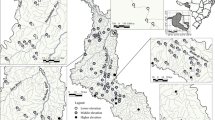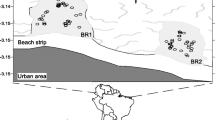Abstract
The fish fauna of the Cinaruco River, an intermediate sized floodplain river that forms the southern boundary of the newly established Santos Luzardo National Park in the llanos of Venezuela, was sampled in 1993-1994. Due to highly seasonal rainfall, the nutrient-poor Cinaruco undergoes dramatic changes in water level, creating a variety of seasonally available habitats for fishes. Sand bank habitats are conspicuous features in both main-channel and lentic backwater areas, and support fish assemblages that are different from adjacent rocky shore and shrubby shore habitats. Seine samples from sand bank habitats revealed high alpha diversity, dominated numerically by a few species of small Characiformes. Comparisons among and between lagoon, side-channel, and main-channel sand bank habitats showed little assemblage similarity. Overall, sand bank habitats were used by 8 orders, 21 families, and 105 species of fish, mostly of size classes less than 100 mm. Several species are currently undescribed. Elements which may contribute to high fish diversity include proximity to a diverse Amazonian fauna, seasonally dynamic habitat availability, the influence of keystone predators, and episodes of intermediate disturbance, such as seasonal release from intense biotic interactions.
Similar content being viewed by others
References cited
Angermeier, P.L. & J.R. Karr. 1983. Fish communities along environmental gradients in a system of tropical streams. Env. Biol. Fish. 9:117–135.
Bayley, P.B. 1988. Factors affecting growth rates of young tropical fishes: seasonality and density-dependence. Env. Biol. Fish. 21:127–142.
Boujard, T. 1992. Space-time organization of riverine fish communities in French Guiana. Env. Biol. Fish. 34:235–246.
Goulding, M. 1980. The fishes and the forest: explorations in Amazonian natural history. University of California Press, Los Angeles. 280 pp.
Goulding, M., M.L. Carvalho & E.G. Ferreira. 1988. Rio Negro, rich life in poor water. SPB Academic Publ., The Hague. 189 pp.
Ibarra, M. & D.J. Stewart. 1989. Longitudinal zonation of sandy beach fishes in the Napo River Basin, Eastern Ecuador. Copeia 1989:364–381.
Junk, W.J., P.B. Bayley & R.E. Sparks. 1989. The flood pulse concept in river-floodplain systems. pp. 110–127. In: D.P. Dodge (ed.) Proc. Internat. Large River Symp., Can. Spec. Publ. Fish. Aquat. Sci. 106.
Krebs, C.J. 1989. Ecological methodology. Harper and Row, New York. 654 pp.
Lowe-McConnell, R.H. 1964. The fishes of the Rupununi savanna district of British Guiana, South America. Part 1. Ecological grouping of fish species and effects of the seasonal cycle on the fish. J. Linn. Soc. Lond. (Zool.). 45:103–144.
Lowe-McConnell, R.H. 1969. Speciation in tropical freshwater fishes. Biol. J. Linn. Soc. 1:51–75.
Lowe-McConnell, R.H. 1979. Ecological aspects of seasonality in fishes of tropical waters. Symp. Zool. Soc. Lond. 44:219–241.
Lowe-McConnell, R.H. 1987. Ecological studies in tropical fish communities. Cambridge University Press, Cambridge. 382 pp.
Meade, R.H. & L. Koehnken. 1991. Distribution of the river dolphin Inia geoffrensis in the Orinoco river basin of Venezuela and Columbia. Interciencia 16:300–312.
Prejs A. & K. Prejs. 1987. Feeding of tropical freshwater fishes: seasonality in resource availability and resource use. Oecol. 71:397–404.
Rodríguez, M.A. & W.M. Lewis, Jr. 1994. Regulation and stability in fish assemblages of neotropical floodplain lakes. Oecologia 99:166–180.
Saul, W.G. 1975. An ecological study of the fishes at a site in upper Amazonian Ecuador. Proc. Acad. Nat. Sci. Philadelphia 127:93–134.
Sioli, H. 1975. Tropical rivers as an expression of their terrestrial environment. pp. 275–288. In: F.B. Golly & E. Medina (ed.) Tropical Ecological Systems. Springer-Verlag, New York.
Taphorn, D.C. 1992. The characiform fishes of the Apure River drainage, Venezuela. Biollania, Special Publ. 4:1–537.
Vannote, R.L., G.M. Minshall, K.W. Cummins, J.R. Sedell & C.E. Cushing. 1980. The river continuum concept. Can. J. Fish. Aquat. Sci. 37:130–137.
Winemiller, K.O. 1989. Ontogenentic diet shifts and resource partitioning among piscivorous fishes in the Venezuelan llanos. Env. Biol. Fish. 26:177–199.
Winemiller, K.O. & D. Taphorn. 1989. La evolución de las estrategias de vida en los peces de los llanos occidentales de Venezuela. Biollania 6:77–122.
Winemiller, K.O. & M.A. Leslie. 1992. Fish assemblages across a complex, tropical freshwater/marine ecotone. En. Biol. Fish. 34:29–50.
Winemiller, K.O. & K.A. Rose. 1992. Patterns of life history diversification in North American fishes: implications for population regulation. Can. J. Fish. Aquat. Sci. 49:2196–2218.
Author information
Authors and Affiliations
Rights and permissions
About this article
Cite this article
Jepsen, D.B. Fish species diversity in sand bank habitats of a neotropical river. Environmental Biology of Fishes 49, 449–460 (1997). https://doi.org/10.1023/A:1007371132144
Issue Date:
DOI: https://doi.org/10.1023/A:1007371132144




